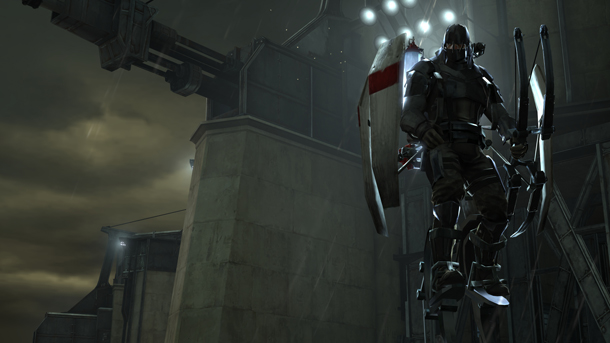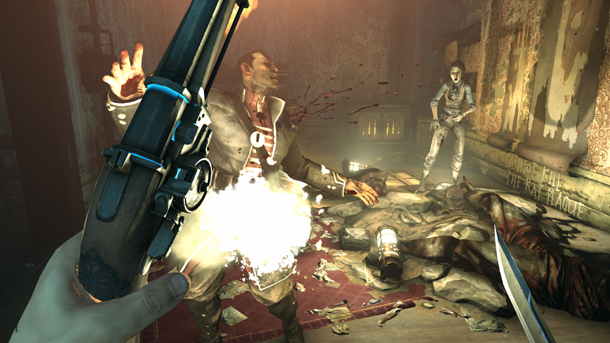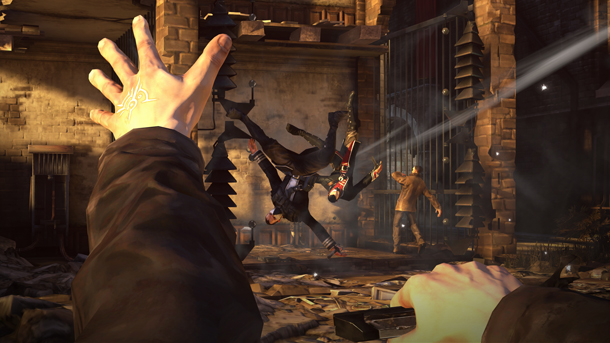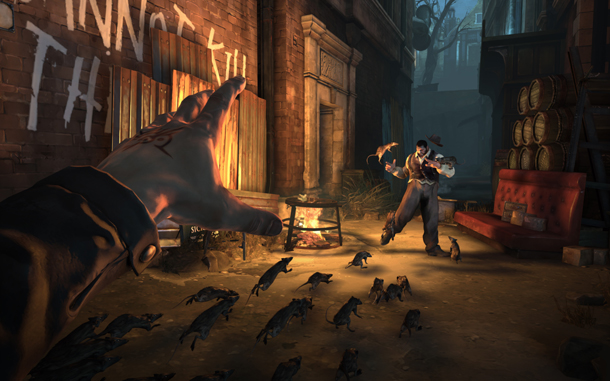
“Play the way you want”.
Boy, that’s an understatement. When Raphael Colantonio and Harvey Smith of Arkane Studios showed us a demo of Dishonored at E3 last week, they emphasized that there was more than one solution to resolving any of the game’s tasks. In the game, players take on the role of a “spiritual assassin” falsely accused of murder. That’s “Point A”. “Point B” is the ending, which for all intents and purposes will be based around the protagonist’s redemption.
That’s the only certainty about the path that Colantonio and Smith want the players to know. This is your starting point, this is your goal; get there however you can.
Dishonored is more about the tools given us rather than a specific narrative. Yes, the plot will be deep and intriguing and the characters and situations we come across will be memorable. But it’s the supernatural aspect and how we incorporate it into the world and those situations that is really the focus of the experience.

Armed with abilities like teleport jumping across short distances, possessing people and animals, and using wind to blow thrown grenades back at enemies, each situation and conflict can be resolved in any number of ways. In the demo that we saw, the player took a stealth route: possessing a fish to swim through a gutter into a nightclub, avoiding enemies on their way to the penthouse suite, possessing a target and knocking him off of a terrace ledge with a wind blast. It essentially makes it look like an accident. In another playthrough, the same player took an aggressive path, decimating enemies with crossbows and pistols along the way to the target.
When I had a chance to try the game for myself I mixed both stealth and aggression, and threw in a bit of luck as well. At the onset I was asked to enter a laboratory where certain nefarious deeds were taking place. On my way there, I noticed several broad-shouldered enemies walking around their scouting positions. I instinctively spawned a few rats, one of the supernatural abilities, to attack them. The rats opted to stay in one spot, so it was up to me to run out and teleport quickly to the enemies’ locations, sneaking up behind them and bludgeoning them with my knife.
One note: a lot of bodies get decapitated in this game. Whether it was how I was attacking or how the developers had set up the demo, it seemed as though everything I used resulted in melons popping off of shoulders. It’s E3, so that was fine with me.

The art and design of the world was highly interesting to me. “Steampunk meets London meets Half-Life” seemed to resonate in my head. The team is known for their quality of visual work, but it was perhaps the audio side that really stuck out. Standing behind closed doors, around corners, or even diving in water as a fish muffled the audio differently. It helped to set up the spacial aspect, as if I knew that I could only make just so much noise before being discovered. During the presentation earlier, Colantonio really emphasized that all of the (presentable) senses would be in use in the game: site, sound, touch (through vibration) and even the spiritual sixth sense.
The guardsmen weren’t easy kills, though, and I soon found myself running back to my starting point. Luckily, I managed to run past the pile of rats that I had spewed earlier, resulting in the vermin reacting to the enemy and immediately devouring him in one of the most grotesque kills in video game history.

It’s that kind of “happy accident” that aims to make each Dishonored playthrough different from the last. Play as a stealth assassin or an aggressive prick, or at some point mix the two together for varying effects. In the end we’ll still get to that Point B, but our road there might consist of a few interesting detours and alternate routes that our friends didn’t see when they used their Supernatural Google Maps.

No Comments